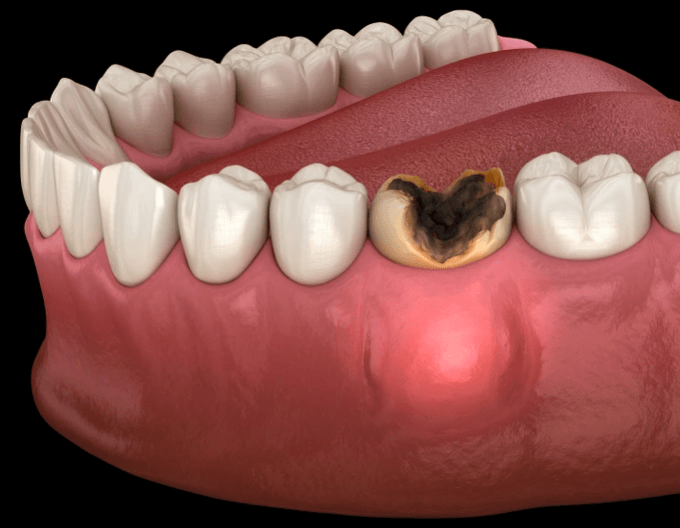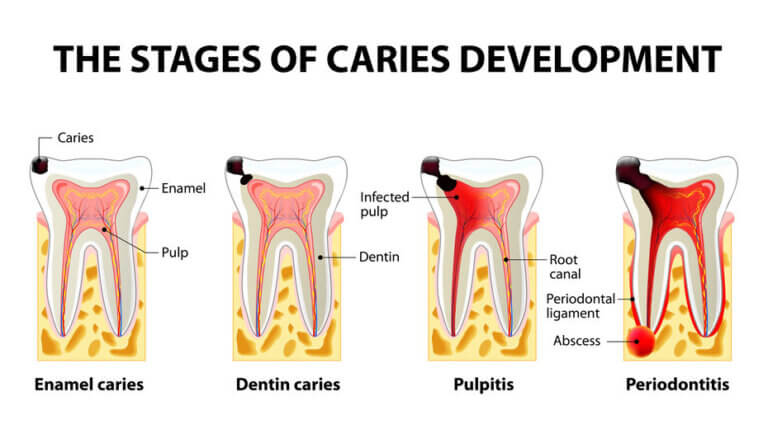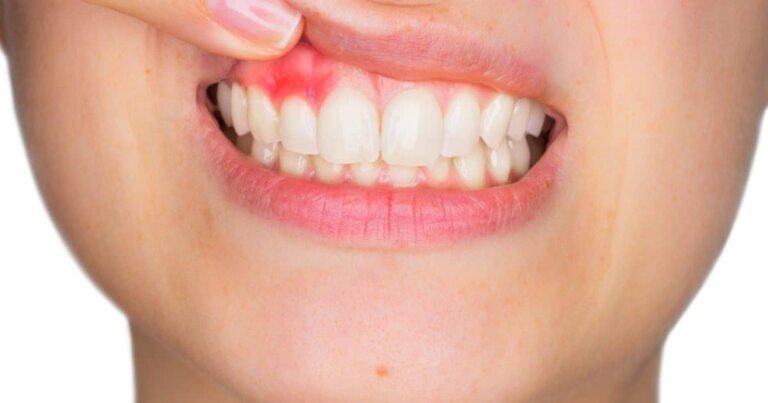Pulp Necrosis

What Is Pulp Necrosis?
Pulp Necrosis is a dental condition that occurs when the innermost tissue of a tooth, known as the pulp, undergoes a process of irreversible damage and ultimately dies. The pulp is a vital component of a tooth, situated beneath the harder outer layers called enamel and dentin. This intricate tissue is responsible for maintaining the tooth’s health and functionality.
The dental pulp comprises a network of blood vessels, nerves, and various types of cells that serve several essential functions. It is responsible for supplying nutrients and oxygen to the tooth, as well as for transmitting sensory signals, such as pain, to the brain in response to external stimuli, such as hot or cold temperatures. Additionally, the pulp plays a pivotal role in the formation of dentin, a hard tissue that constitutes the bulk of a tooth’s structure.
Pulp necrosis can be triggered by various factors, including untreated dental cavities, trauma to the tooth, advanced gum disease, or dental procedures that involve extensive drilling or trauma to the tooth. When the pulp becomes necrotic, it can lead to severe toothaches, dental infection, and, if left untreated, the loss of the affected tooth. Dental treatment, such as root canal therapy, is often necessary to address pulp necrosis, where the damaged or infected pulp is removed to alleviate pain and preserve the tooth’s function.
Before you contact a Toronto dentist to examine Pulp Necrosis, there are some things you should know as a patient:
- Why Do I Have Pulp Necrosis?
- Signs And Symptoms Of Pulp Necrosis
- Treatment Options For Pulp Necrosis
- Managing Pulp Necrosis Until You Can See The Dentist
- Frequently Asked Questions About Pulp Necrosis
If you have questions about Pulp Necrosis or other dental problems, please contact us for more information.
Why Do I Have Pulp Necrosis?
Some common reasons for pulp necrosis include:
- Deep Cavities (Dental Caries): Untreated tooth decay allows bacteria to infiltrate the pulp, leading to inflammation and eventual necrosis.
- Cracked Teeth: A tooth fracture can provide a pathway for bacteria to access the pulp, causing infection and necrosis.
- Dental Procedures: Multiple or unsuccessful dental treatments can make a tooth more susceptible to pulp necrosis.
- Trauma or Injury: Physical trauma to a tooth can expose the pulp, disrupting blood supply and leading to tissue death.
- Worn Tooth Enamel: Aggressive tooth brushing or teeth grinding can wear down enamel, enabling bacteria to enter the tooth, potentially leading to necrosis.
If you suspect you have Pulp Necrosis or are experiencing dental pain, it’s crucial to seek prompt dental care. A dentist will assess your condition and recommend an appropriate treatment plan, which may include root canal therapy or tooth extraction to alleviate the pain and prevent further complications. For more information about Pulp Necrosis, please contact us.

Signs And Symptoms Of Pulp Necrosis
Recognizing the signs and symptoms of pulp necrosis is crucial for timely intervention and relief from dental pain. Here’s what to look out for:
- Toothache: Pulp necrosis often presents with persistent, throbbing tooth pain that can intensify when eating, drinking, or applying pressure to the affected tooth.
- Tooth Sensitivity: Individuals with pulp necrosis may experience heightened sensitivity to hot, cold, or sweet foods and beverages.
- Absence of Sensitivity: In advanced stages, where the nerve has died, there may be a lack of sensitivity to temperature and sweets, yet discomfort may persist when tapping the tooth.
- Radiating Pain: In some cases, the pain from pulp necrosis can radiate to the jaw, neck, or even the chest, indicating a more severe condition that requires immediate attention.
If you suspect you have Pulp Necrosis or are experiencing dental pain, it’s crucial to seek prompt dental care. A dentist will assess your condition and recommend an appropriate treatment plan, which may include root canal therapy or tooth extraction to alleviate the pain and prevent further complications. For more information about Pulp Necrosis, please contact us.
Treatment Options For Pulp Necrosis
The primary treatment options for pulp necrosis are:
- Root Canal Therapy: A common treatment, a root canal involves removing the necrotic pulp, cleaning the tooth’s root, and sealing the root canal. This preserves the natural tooth. Afterwards you will require a dental filling to patch the hole and a dental crown to reinforce the tooth.
- Tooth Extraction: In cases where the tooth is severely damaged or when root canal therapy is not a viable option, extraction becomes necessary. While losing a tooth is not ideal, it may be the only solution to prevent further complications. Tooth replacement options include a dental implant, dental bridge, or denture.
- Antibiotics: In situations where dental infection cannot be resolved with local measures, dentists may prescribe antibiotics to manage the spread of bacteria. This is especially important if patients exhibit systemic signs of infection, such as fever.
The choice between these treatment options depends on various factors, including the extent of damage, the location of the affected tooth, your overall oral health, and your personal preferences. Your dentist will discuss the pros and cons of each option with you and help you make an informed decision. For more information about Pulp Necrosis, please contact us.

Managing Pulp Necrosis Until You Can See The Dentist
Here are some strategies to help alleviate the pain:
- Use Over-the-Counter Pain Medication: Over-the-counter pain medication can help relieve tooth pain from Pulp Necrosis. You are also welcome to use over the counter pain relievers such as ibuprofen (Advil) or acetaminophen (Tylenol). Ask your dentist what dosage is right for you, but if you do not have a pre-existing medical condition of allergies, 1000mg acetaminophen (Tylenol) with 600mg ibuprofen (Advil) every 4-6 hours or as needed is a very powerful combination.
- Cold Compress: Applying a cold compress to the outside of your cheek can help reduce inflammation and numb the affected area, providing some relief.
- Avoid Trigger Foods: Stay away from hot, cold, or sugary foods that can exacerbate the pain. Opt for softer, lukewarm options to minimize discomfort.
- Elevate Your Head: Keeping your head elevated while sleeping can reduce blood flow to the affected tooth and ease pain.
- Rinse With Saltwater: Rinsing your mouth with warm saltwater can help reduce inflammation and kill bacteria. Mix a teaspoon of salt in a cup of warm water and swish the solution around your mouth for about 30 seconds before spitting it out. Alternatively, you can buy and use any mouthwash available at your pharmacy or health foods store
- Practice Good Oral Hygiene: Keeping the area around your affected tooth clean as possible can help prevent further damage and alleviate some of the tooth pain. Brush and floss gently around the tooth. Use a soft-bristled toothbrush to minimize further irritation of the affected tooth.
While these strategies may offer temporary respite, they are not long-term solutions. It’s essential to schedule an appointment with a dentist as soon as possible for proper diagnosis and treatment to address the root cause of Pulp Necrosis. For more information about Pulp Necrosis, please contact us.
Frequently Asked Questions About Pulp Necrosis
- Is pulp necrosis reversible?
No, once the pulp tissue has died, the condition is irreversible. Treatment, such as a root canal or extraction, is necessary to resolve the issue.
- Can I avoid a root canal if I have pulp necrosis?
A root canal is typically the best option to save the tooth. Without treatment, the infection can worsen, leading to more severe complications or the need for extraction.
- Does pulp necrosis always cause pain?
Not always. In some cases, the tooth may no longer be sensitive as the nerve dies. However, infection-related pain or swelling may still develop.
- Can pulp necrosis affect other teeth?
If left untreated, the infection from pulp necrosis can spread to nearby teeth, gums, and even the jawbone, causing further complications.
By understanding pulp necrosis and its treatment options, you can take proactive steps to protect your oral health. If you suspect you have this condition, contact us at Atlas Dental right away for a thorough evaluation and personalized care.

